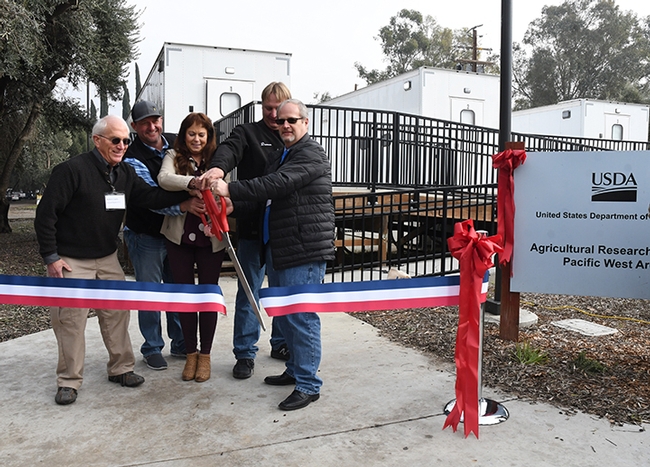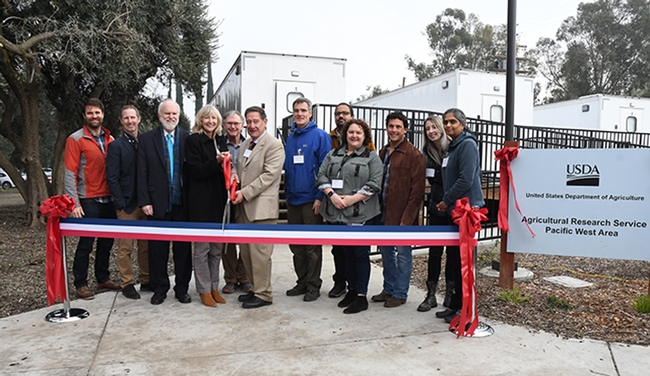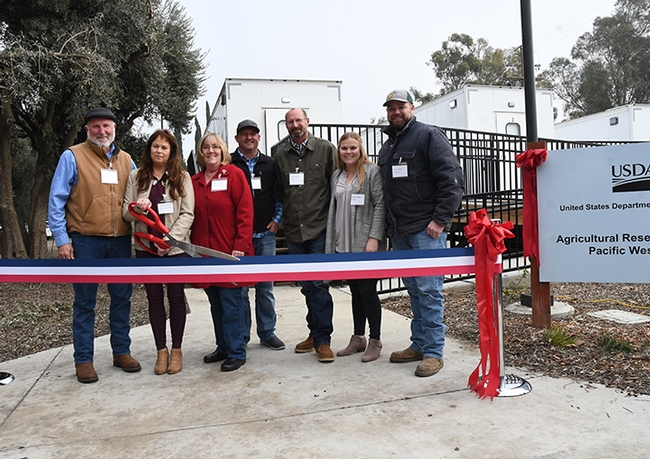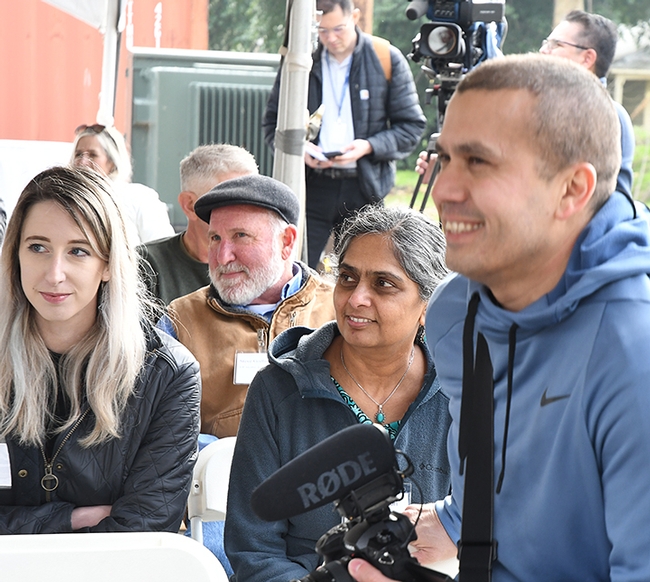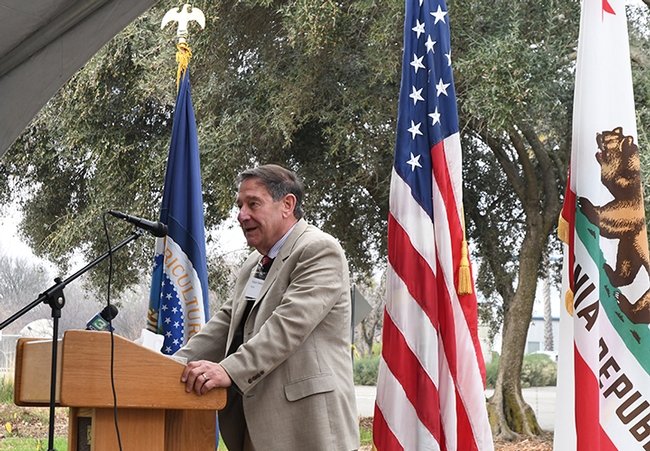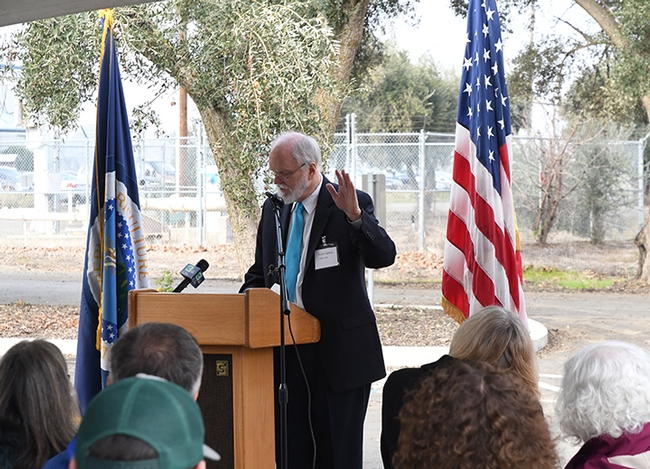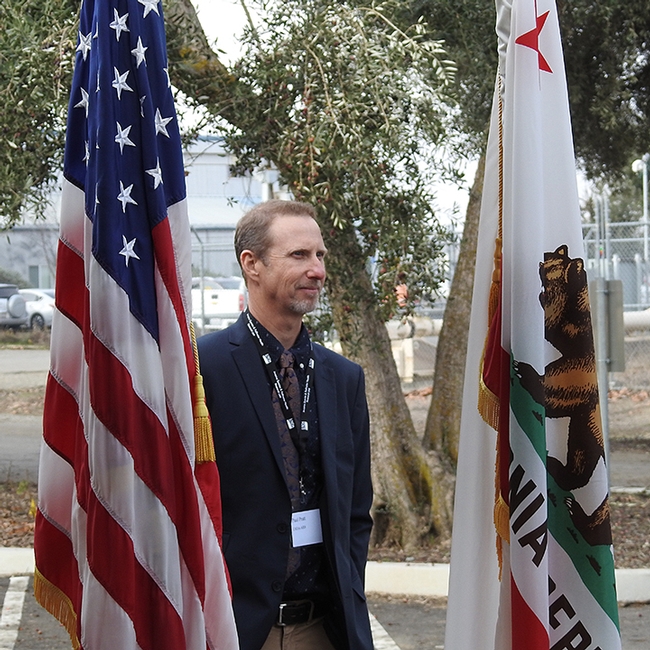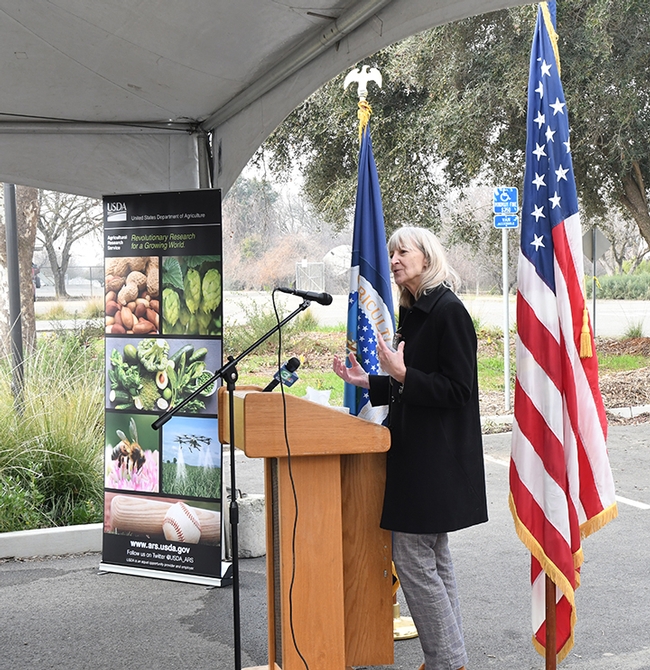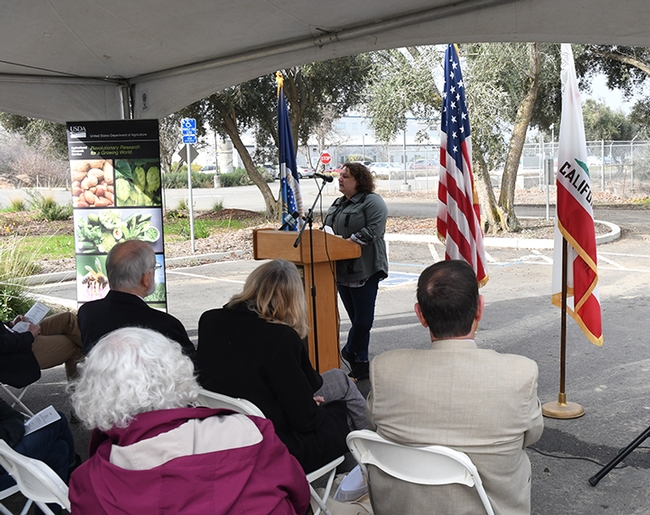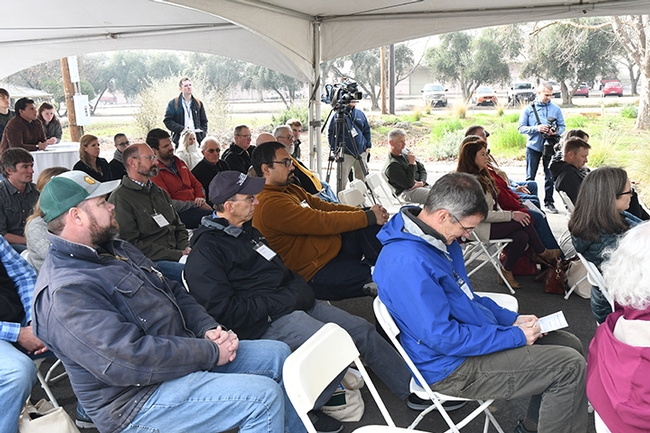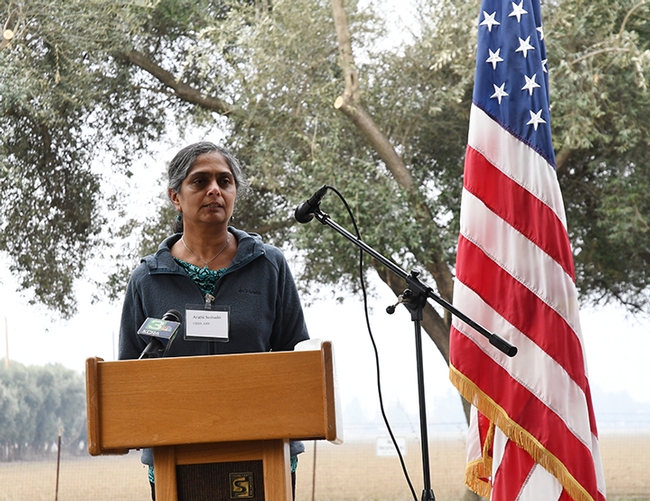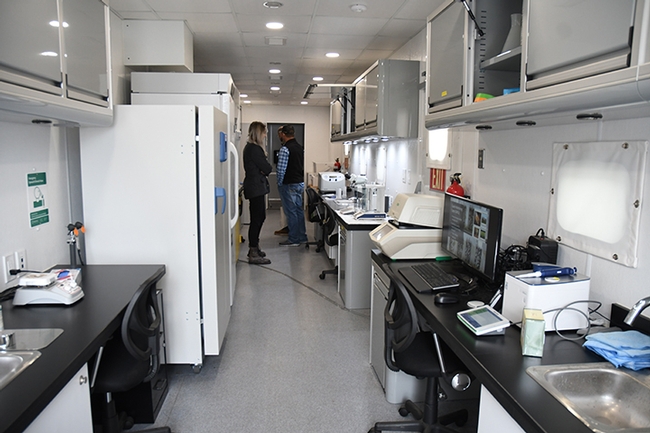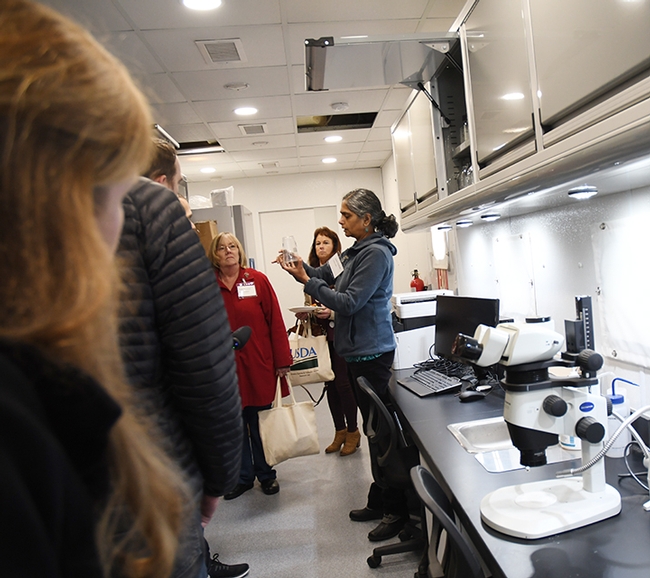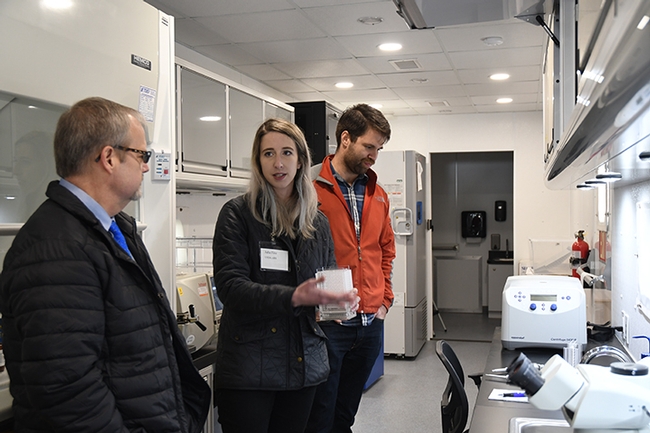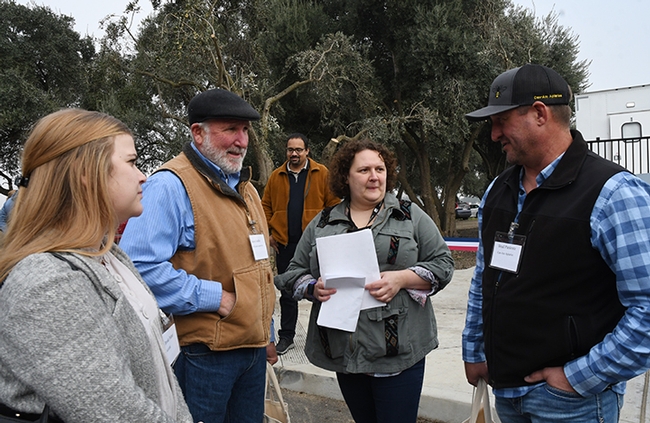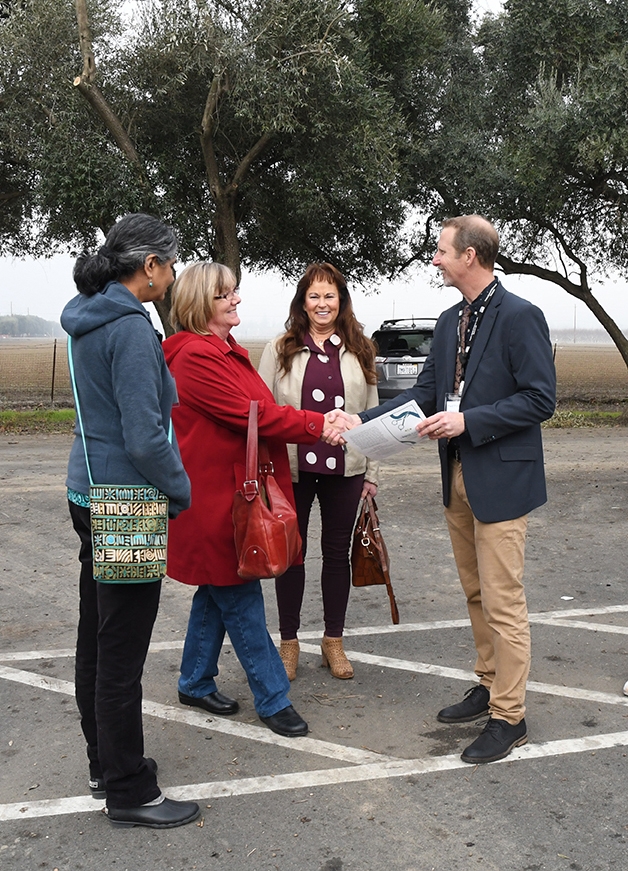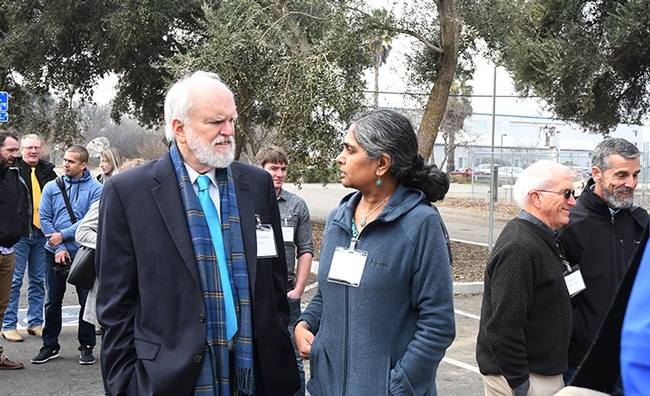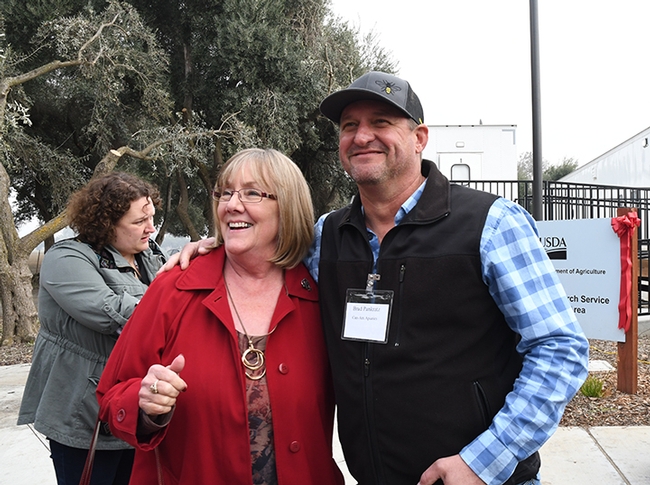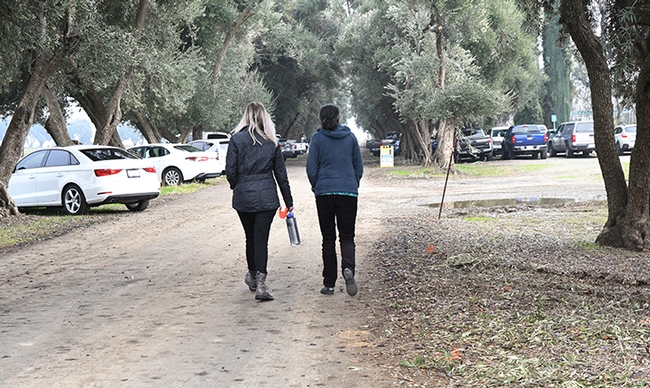- Author: Kathy Keatley Garvey
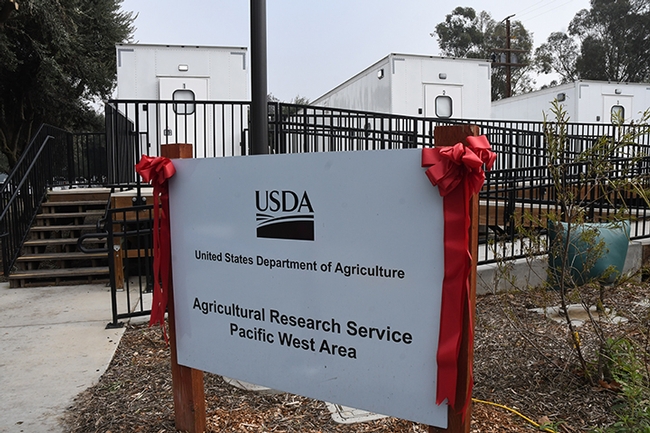
Queen bee breeder Jackie Park-Burris, a past president of the California State Beekeepers' Association and a leader in the industry, snipped the ribbon Jan. 7 in 45-degree temperature, joining a group of other stakeholders to open the U.S. Department of Agriculture's Agricultural Research Service (USDA-ARS) bee research facility.
The facility, located next to the UC Davis Department of Entomology and Nematology's Harry H. Laidlaw Jr. Honey Bee Research Facility, slides Davis into the national spotlight as "Pollination Central" and "The Bee Capital of the World." The Davis facility is the newest of five USDA bee research labs in the United States and as the only one in California.
“This is the only USDA bee research team in California—where the action is,” said emcee Paul Pratt, research leader of the Invasive Species and Pollinator Health Research Lab. USDA maintains honey bee research facilities in Tucson, Ariz.; Beltsville, M.D., Baton Rouge, La., and Stoneville, Miss.
“The opening of the USDA-ARS bee lab marks a new opportunity for USDA and UC Davis entomologists to collaborate and investigate serious problems that affect stakeholders,” said Steve Nadler, professor and chair of the UC Davis Department of Entomology and Nematology. “We are very fortunate that the lab was built at UC Davis.”
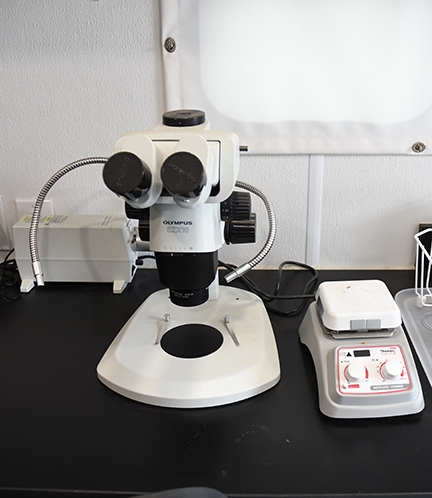
Park-Burris, of Jackie Park-Burris Queens, Palo Cedro--her family has worked with UC Davis researchers for more than 80 years--cut the ribbon with four other stakeholders: almond pollination consultant Robert Curtis of Carmichael, former director and associate director (now retired) of Agricultural Affairs, Almond Board of California; Kevin Adee of Bruce, S.D., president of the American Honey Producers' Association; Brad Pankratz of Can-Am Apiaries, Orland, Calif.; and Darren Cox of Cox Honey Farms, Logan, Utah, a past president of the American Honey Producers' Association.
Pratt introduced newly hired research entomologists, Arathi Seshadri and Julia Fine, forming the Invasive Species and Pollinator Health Research Unit at Davis. They are dedicated toward developing technology that improves colony survivorship through long-term studies of multiple stress factors, he said. "They will develop and transfer integrated biologically based approaches for the management of invasive species and the improvement of pollinator health.”
Seshadri and Fine aim to improve honey bee survival and beekeeping sustainability in California and nationwide, Pratt said. They will collaborate with federal, university, non-governmental and industry partners.
Seshadri, a pollination biologist with expertise in honey bee behavior and plant reproductive strategies, will be working with beekeepers and farmer stakeholders to develop projects aimed at finding solutions to the ongoing pollination challenges. Also trained as an evolutionary biologist, she has applied principles of plant-pollinator mutualism, specifically the impact of phytochemicals in pollen and nectar on honey bee health and colony performance. Her contributions to pollinator conservation include enhancing the sustainability of all pollinators, including native bees on farms and urban areas. She also has expertise in agroecosystem-based approaches and citizen science programs to promote pollinator diversity and abundance.
Fine, an entomologist with expertise in insect toxicology, honey bee physiology, reproduction and development, focuses her research on identifying how stressors impact honey bee behavior, health and fecundity. She uses both established and novel laboratory techniques. Her previous projects involved investigating how agrochemical and viral stressors interact to affect the development and survival of honey bee brood and how nutritional stress affects honey bee queen fecundity. In engaging with beekeepers and growers, Fine will research how realistic biotic and abiotic stressors affect honey bee reproduction, longevity and pollination services, and she aims to identify techniques and strategies to overcome these effects.
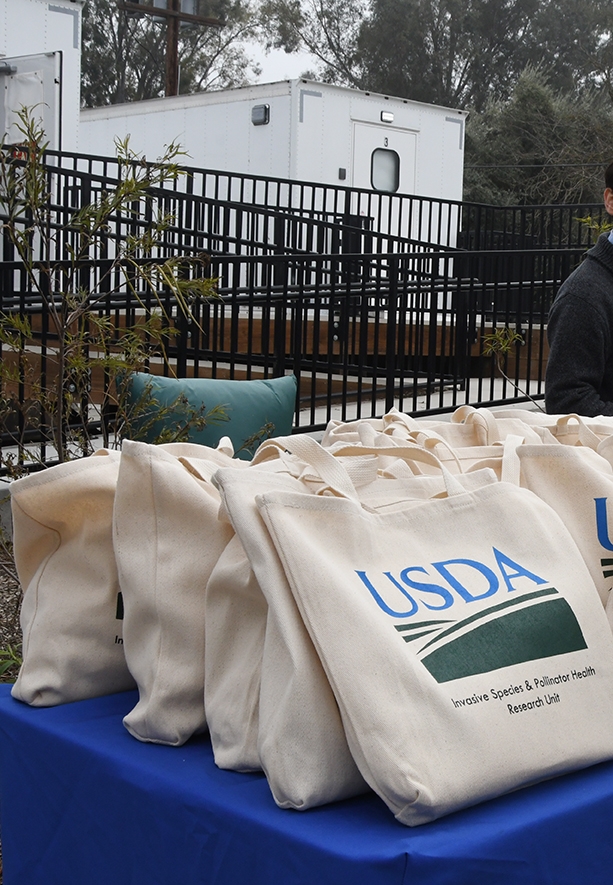
“We don't need to tell the people here how important honey bees are to agriculture, to the natural environment and the importance of minimizing costs to honey bee industry,” Matteri told the crowd. He noted that researchers, through collaboration and cooperation, have made great strides in nutrition, physiology, pathology, environmental factors.
"We've learned a lot,” Matteri said, “and we're looking forward to many good things to come.”
'Bee Capital of the World'
Associate Dean Oberbauer, pointing out the many “individuals focused on apiculture on the UC Davis campus,” described Davis as “the bee capital of the world.”
“The location of this new honey bee lab right next to the Harry H. Laidlaw Jr. Honey bee Research Facility… offers faculty, students and USDA a unique opportunity for expanding partnerships, internships and collaborative research for faculty and students,” she said.
The associate dean lauded the UC Davis research, teaching and public service in apiculture and the what's to come. “We are extremely fortunate and pleased to have this new USDA honey bee lab so close to our researchers and we look forward to this continued partnership in the years to come,” Oberbauer concluded.
USDA's Pacific West Area Director Hackett told the crowd that “for me, this is a homecoming.” After receiving his doctorate at UC Berkeley, he worked in research with UC Davis Professor Robbin Thorp (1933-2019), when “American foulbrood was a hot topic.”
Hackett thanked stakeholders for “your help in bringing this lab here…Your funding on behalf of industry is what made this bee lab come about and we really thank you for that.” He singled out the American Beekeeping federation, American Honey Producers' Association, California State Beekeepers' Association and Almond Board of California.
“With this Davis lab," Hackett said, "we are situated in Pollination Central, in the heart of the almond and tree fruit industry."
“Varroa mites” topped the list of concerns at the November 2015 stakeholder conference, Hackett pointed out, adding that “It will be studied in context with other stressers such as pesticides.”
“We're really looking forward to solving ALL the bee problems,” Hackett quipped, to applause. Research will include “how do you combine treatments to improve honey bee health especially from protecting bees from varroa in this agriculturally intensive, high pollination unit location.”
Hackett said it's a tremendous opportunity for USDA scientists to partner with UC Davis Entomology and Nematology faculty. The bee faculty include researchers Brian Johnson, behavior ecology; Neal Williams, pollination ecology; and Extension apiculturist Elina Lastro Niño. Faculty member Rachel Vannette, a community ecologist, also works with bees.
“By working together we will be able so synergize all of our efforts to help the bee industry and to ensure pollination in country's major specialty crops,” Hackett said.
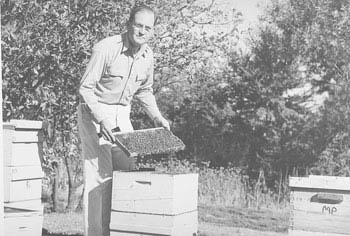
Extension apiculturist Elna Niño chronicled the history of the bee biology program at UC Davis. The first bee instructor was George Haymaker Vansell (1892-1954) a USDA employee in the Davis Experiment Station. A former student at UC Davis, he taught from 1920 to 1931. His research led to a better understanding of the role of bees in crop pollination.
Among the other faculty mentioned: Harry Hyde Laidlaw Jr. (1907-2003), known as “the father of honey bee genetics,” who joined the department in 1947; Professor (now emeritus) Norman Gary, faculty member from 1962 until his retirement 1994; Distinguished Professor Robbin Thorp (1933-2019), faculty member 1964 to 1994; Distinguished Emeritus Professor Robert E. Page, Jr., who served on the faculty from 1989 to 2004; and Eric Mussen, Extension apiculturist (now emeritus) from 1976 through 2014. (See history of bee biology program)
Gary led the efforts to obtain funds to construct the bee biology facility (renamed the Harry H. Laidlaw Jr. Honey Bee Research Facility), starting with a National Science Foundation facilities grant. He designed the facility, located his primary office there for almost 25 years, and persuaded the Chancellor office to name the access road as Bee Biology Road.
More current members of the faculty: Neal Williams joined the department in 2009; Brian Johnson, 2012; and Elina Niño. 2014.
'We Are Grateful'
In her talk, Park-Burris said that the “California State Beekeepers' Association is overwhelmed that we have a USDA lab to collaborate with our UC Davis lab. We hope there's a lot of collaboration going on. We really look forward to that. As a stakeholder, my family has been raising queens just north of here (Palo Cedro) for over 80 years. Dr. Laidlaw had worked with my uncle and my father. He's been at my house. And he's been through my bees. Julia (Fine) has even already been up to see the queen farm.”
“The queen bee breeding industry could definitely use you guys,” Park-Burris continued. “California has all the issues because everybody comes here. …it's very important that we have this lab here and how grateful we are that you have all gone to the work to make this happen."
“We look forward to solving some of our problems—varroa, varroa, varroa--and forage and pesticide interaction,” Park-Burris said, “and all that happens in California during the largest pollinator event in the world. So you're in a good place and we're grateful.”
Extension apiculturist emeritus Eric Mussen later commented: "I think that the collaboration among the new USDA bee lab personnel, cooperating researchers, and beekeepers should provide an opportunity to probe deeply into potential causes of colony loss. The ability to follow the health of individual bees and colonies, throughout the year, should provide important clues about precursors of colony decline, well in advance of the ultimate collapse."
